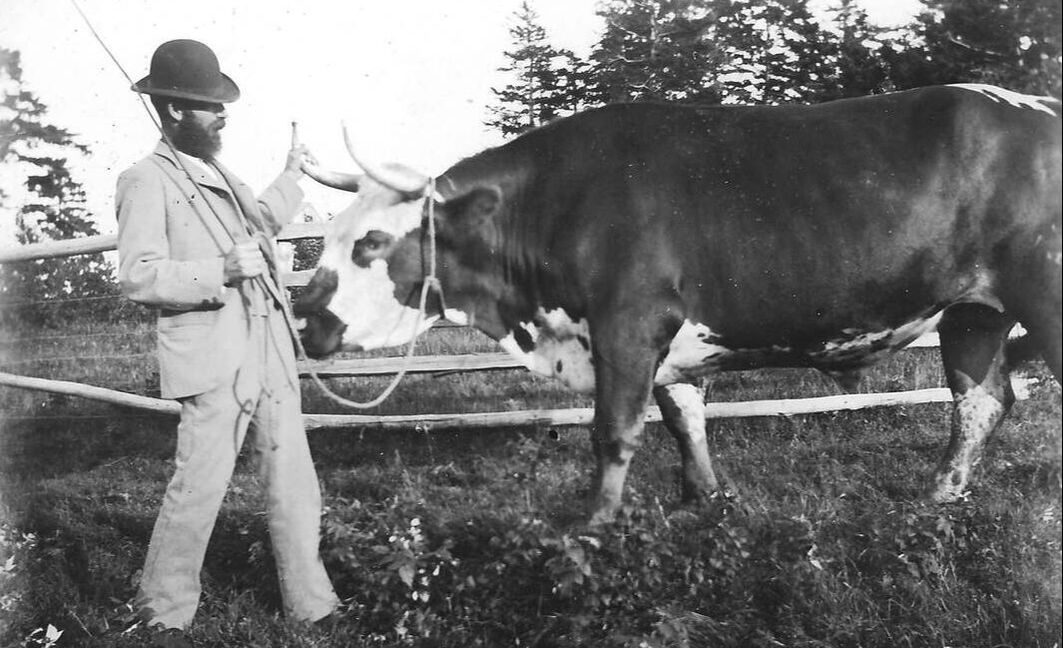ISLAND GROWN
No part of the state produces better beef, pork, mutton, butter, and cheese.
Benjamin Beverage, 1819, North Haven
Despite the long days of seemingly endless work, islanders took pride in farming. Thomas Waterman wrote in 1821:
The soil of the North Island...produces corn, wheat, rye, barley, and oats, and vegetables in abundance; butter, cheese, beef, pork, and mutton are raised here for market of superior quality...The inhabitants of the North Island are principally employed in cultivating the soil, which affords them a comfortable support for themselves and their families.
By the early 19th century, island farmers began to transition from subsistence farming, in which they raised nearly all that the farm family needed for food, fuel, clothing, and shelter. Over time, farmers raised less for themselves and more for sale off the farm in order to earn money for taxes, farm operations, and a family living.
Agricultural Census records for North Haven provide a view into the number and size of island farms as well as what crops and livestock they raised. Among the farm animals kept on island farms, none proved more popular than sheep. In 1850, the Agricultural Census noted 71 farms and reported 2,156 sheep on North Haven, approximately double the population of people on the island at the time! Most farms averaged about 25 to 50 sheep, although Melzar Waterman (whose farm was located on the present site of the North Haven golf course) had the largest flock with 150 sheep.
Most of the wool from island sheep was shipped to the Knox Woolen Mill in Camden and Charles Merritt, the president of the mill, proclaimed, "Island wool is cleaner, has a longer staple, and is superior in every respect."
North Haven farmer and businessman, Frank Beverage, recalled:
I bought thousands of pounds of wool from North Haven, Vinalhaven, and the neighboring islands for the Knox Woolen Mill in Camden, Maine. 12,000 pounds was the average pack for which I paid 25 cents and up a pound, and at that time, which was about 1886, a check was not acceptable by the wool farmers, so all the business was strictly on a cash basis with as much gold as possible. One can easily see that the cash in the house caused me and my family more uneasiness and worry than the wool did.
In addition to the highly prized island wool, North Haven lamb gained a reputation for being exceptional. Raised on grass salted by the ocean breezes, the meat from island sheep developed a unique and very favorable taste, known in French cuisine as “pré sale.” Highly coveted by chefs, North Haven lamb was, as often reported by local legend, featured on the menu of the Ritz Hotel in Boston and New York City.
Benjamin Beverage, 1819, North Haven
Despite the long days of seemingly endless work, islanders took pride in farming. Thomas Waterman wrote in 1821:
The soil of the North Island...produces corn, wheat, rye, barley, and oats, and vegetables in abundance; butter, cheese, beef, pork, and mutton are raised here for market of superior quality...The inhabitants of the North Island are principally employed in cultivating the soil, which affords them a comfortable support for themselves and their families.
By the early 19th century, island farmers began to transition from subsistence farming, in which they raised nearly all that the farm family needed for food, fuel, clothing, and shelter. Over time, farmers raised less for themselves and more for sale off the farm in order to earn money for taxes, farm operations, and a family living.
Agricultural Census records for North Haven provide a view into the number and size of island farms as well as what crops and livestock they raised. Among the farm animals kept on island farms, none proved more popular than sheep. In 1850, the Agricultural Census noted 71 farms and reported 2,156 sheep on North Haven, approximately double the population of people on the island at the time! Most farms averaged about 25 to 50 sheep, although Melzar Waterman (whose farm was located on the present site of the North Haven golf course) had the largest flock with 150 sheep.
Most of the wool from island sheep was shipped to the Knox Woolen Mill in Camden and Charles Merritt, the president of the mill, proclaimed, "Island wool is cleaner, has a longer staple, and is superior in every respect."
North Haven farmer and businessman, Frank Beverage, recalled:
I bought thousands of pounds of wool from North Haven, Vinalhaven, and the neighboring islands for the Knox Woolen Mill in Camden, Maine. 12,000 pounds was the average pack for which I paid 25 cents and up a pound, and at that time, which was about 1886, a check was not acceptable by the wool farmers, so all the business was strictly on a cash basis with as much gold as possible. One can easily see that the cash in the house caused me and my family more uneasiness and worry than the wool did.
In addition to the highly prized island wool, North Haven lamb gained a reputation for being exceptional. Raised on grass salted by the ocean breezes, the meat from island sheep developed a unique and very favorable taste, known in French cuisine as “pré sale.” Highly coveted by chefs, North Haven lamb was, as often reported by local legend, featured on the menu of the Ritz Hotel in Boston and New York City.
